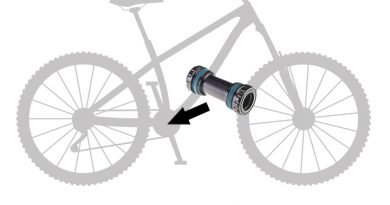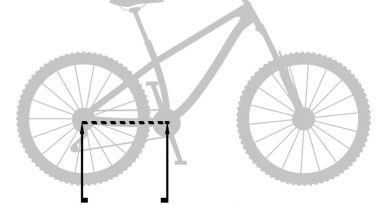What Is The Head Angle On A Bike? | Ultimate Guide
Mountain bike head angle is an interesting topic and is one of the biggest contributing factors to determining how a bike feels for its intended discipline. In this article, we look into all the questions you may have about the head angle from how it affects a bike’s performance, and how to measure your bike’s head and we try to answer all the common questions you might have on the topic.
When reading this article please note that head angle is not the only important metric of a bike’s geometry, and often bike designers have to find a balance between things like wheelbase or chainstay length.
- What Is A Head Angle On A Bike?
- Where Is The Head Angle On A Bike?
- How Do You Measure Bike Head Angles?
- Does Head Angle Change With Frame Size?
- Steep vs Slack Head Angle
- What Is The Average Mountain Bike Head Angle?
- What Is The Average Road Bike Head Angle?
- What Head Tube Angle Do I Need?
- Why Are Mountain Bike Head Angles Getting Slacker?
- How Does Fork Length Affect Head Angle?
- How Do You Slacken The Head Tube Angles?
What Is A Head Angle On A Bike?
The head angle on a bike is the angle at which your forks sit in relation to the bike’s headtube or the angle at which the forks sit in relation to the horizontal line between the front and rear axles.
Where Is The Head Angle On A Bike?
The head angle is located between the head tube and the angle of the forks. The Head angle is the angle of the head tube which is preset by the frame manufacturers. However, it is possible to adust head angle with special headset cups, or offset bushings on full suspension bikes.

How Do You Measure Bike Head Angles?
There are a few ways to measure the headtube angle on a bike:
- Mobile apps:
There are some great mobile apps out there for measuring angles. however, some phones have better hardware than others, which can make the results vary, but most modern phones should do a good job. some popular apps are Bubble level app and Smart Tools app.
2. Digital Level/Angle Gauge:
If you are looking to buy the right tool for the job, you can buy digital lever/angle gauges. They are used commercially and should give a pretty accurate reading.
3. Do the maths:
If you can remember some basic high school trigonometry, you should be able to work out the answer with just a tape measure.
Does Head Angle Change With Frame Size?
Most mountain bike manufacturers tend to keep the head angle the same across all their frame sizes, however, road bike manufacturers tend to steepen the head angle as the frame size increases. However, most of the other mountain bike frame metrics do change with size, for example, top tube, wheelbase, and standover height normally get bigger as the frame size increases. Head angle changes how a mountain bike behaves but does not normally have any relation to frame size.
Steep vs Slack Head Angle
The lower the head angle number in degrees the slacker the head angle. Therefore the higher the number the steeper the head angle. Different mountain bike disciplines require different head angles to help optimize the bike for its intended objective. This means neither a steeper or slacker head angle will not have any specific advantage unless it’s the correct head angle for its intended purpose.
How Does A Steeper Head Angle Effect Handling?
A steeper head angle makes the bike much more responsive at lower speeds and can help the rider manoeuvre the bike through slower, tighter, and more technical terrain. However, the steeper you make the head angle will make the bike less stable at speeds.
How Does A Slacker Head Angle Effect Handling?
Over the years mountain bikes have been rapidly evolving (see the history of the mountain bike), and there is a strong trend toward their head angles getting slacker and slacker. The advantage of a slack head angle is that it makes a bike more stable over rough terrain and at speed. Making a bike feel more stable at speed, can be confidence-inspiring and help improve descending times.
However, it’s worth noting that most modern mountain bike design is driven bike mountain bike racing, which is purely designed to help a rider go as fast as possible, and does not always make the most fun bike to ride. Modern mountain bikes are trending towards slack head angles, long top tubes, and wheelbases, this is great if you are looking to ride fast wide alpine descents, however slower, tighter, technical trails may not be the most ideal with a slack head angle.
What Is The Average Mountain Bike Head Angle?
Taking an average of all mountain bike disciplines, the average head angle is 66.5 degrees. However, the average head angle is much more relevant if you look at the head angle by their individual mountain bike disciplines.
Average Head Angle By Discipline (measured in degrees)

- Cross-country (xc) – 68.5
- Trail Riding – 66
- Enduro – 64.7
- Downhill (DH) – 63.1
- Trials – 73.3
- Dirt/Pump track – 68.5
What Is The Average Road Bike Head Angle?
It’s worth noting that head angle often increases with frame size on road bikes. For example:
The 2021 Specialized Tarmac SL7 the head angle is done by size like this:
| 71.75° – (49) | 72.5° – (52) | 73°-( 54) | 73.5° – (56) | 73.5° – (58) | 74°– (61) |
Road bike – 73° (often changes with frame size)
Gravel bike – 70°
Commuting bike – 70.5° (some brands HA changes with frame size)
What Head Tube Angle Do I Need?
Head angle is specific to the type of bike you are riding. Take a look at the average head angle by bike type (this should be a good place to start). However, it’s worth noting that if the bike’s head angle is within a reasonable range, you should not think about adjusting it unless you are a professional cyclist or a frame designer.
Why Are Mountain Bike Head Angles Getting Slacker?
Mountain bike head angles are getting slacker and slacker mainly due to the bikes being tested and developed for racing. A slack head angle is much more stable and confidence-inspiring, especially when things get fast and rough. The question is how slack is too slack? Contrary to popular belief I would argue we have already hit that point.
The issue with super long, slack bikes is that they are designed to be ridden fast by advanced riders. Whereas the majority of mountain bikers are not at this level, and will not have the ability to force bikes around more technical, tighter terrain. People usually want to ride bikes that are the same as their mountain bike idols, however, what might be fast for them might not be the most enjoyable bike for the average rider.
How Does Fork Length Affect Head Angle?
20mm = 1 degree . This means that if you increase your fork height by 20mm then you will slacken your head angle by 1 degree, and if you decrease your fork high by 20mm then you will steepen the head angle. However, remember when adjusting fork heigh it will also affect other frame geometry metrics like bottom bracket height and wheelbase.
How Do You Slacken The Head Tube Angles?
Offset headset
If you would like to slacken or steepen your head angle the best solution is an offset headset. Offset headsets will vary on the amount you can adjust your head angle, this is either due to the combination of your frame headtube and forks steerer tube size, or the offset headset manufacture. Depending on your frame and forks you can normally find a choice in offsets that range between 0.3° to 2.0°.
Offset bushings
This is only an option for full suspension bikes as these bushings fit between the shock eyelets. Instead of the bushing hole being central, the hole is offset pointing towards the centre of the shock. This works effectively by shortening the shocks eye to eye, but still keeping the same stoke length so you are not reducing the bike’s travel.
Fork height
Every 20mm you increase or decrease your fork height you will slacken or steepen your head angle. Adding a longer travel fork can make a bike feel more stable however the increased height will also increase the bottom bracket height making cornering less responsive.
You may also be interested in:




